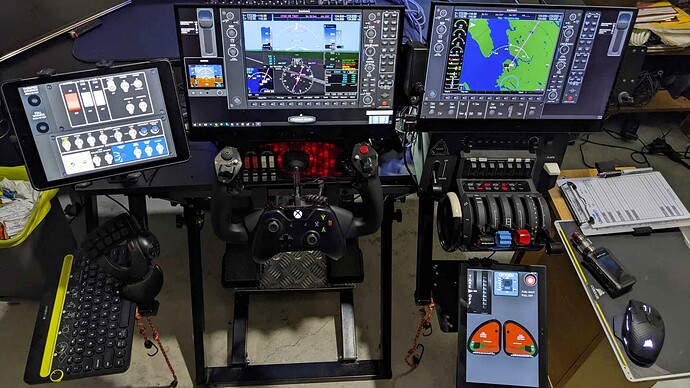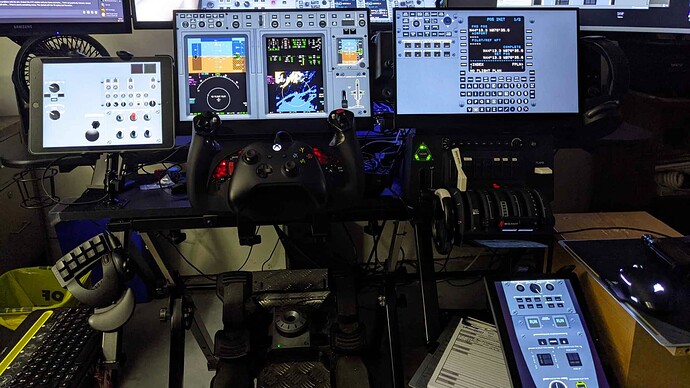I’m looking into using Air Manage but was wondering if the panels can be used for different aircraft? For example would the Cessna 172 panel still work when using the TBM?
That is not a straight forward Yes or No answer. It’s probable that they will but it depends on what sim connect variables each aircraft uses for certain values. If they use the same sim connect variable for say heading then an instrument that displays heading such as a directional gyro will work with all aircraft that use the same variable. The problems normally arise when using an add-on aircraft where the devs have chosen to use a custom variable. The good thing about Air Manager though is the instrument can be made to work with any variable by making a small change. It can also be made to work for a selection of variables if required.
You can also set it to automatically load certain panels with particular aircraft, or can put together your own panel with a series of generic instruments (or make your own - more complicated) to use with any aircraft. When you switch aircraft a different panel would automatically load in Air Manager.
@Crunchmeister71 has extensive knowledge in this area and has built a bunch of pannels, instruments, etc… with his crew (I’ll let him link the stuff).
I have the 172 pannel, works for both Steam and G1000. Also works with the 182T (Carenado) and you can add in some instruments, so yes it is doable.
He may be able to answer further though.
I see that you have experience in creating panels using Air Manager. I’m debating whether to use Air Manager or just pop out the PFD/MFD on a external monitor. I feel that the PFD/MFD would be better, what do you prefer?
The ideal solution involves mixing both the popouts and Air Manager instruments.
I’ve been using Air Manager for just about a year now and only really got into programming instruments for it in any serious manner about 6 months ago. Prior to that, I was just tweaking existing instruments that didn’t behave properly in MSFS for my own personal use.
@Sling380 is the guy who I would wager knows AM better than any other active member on this forum. What I know about AM instrument development was through experimentation and watching his YouTube video tutorials. As far as I’m concerned, anything he says relative to AM should be considered as gospel and trump any perceived “expertise” I may have on the subject.
That said, Sling is quite correct - the ideal is popping out MSFS glass panels to an external monitor and using them along with AM instruments like G1000 bezels, autopilots, etc. It doesn’t have to be 1 or the other. AM is designed to work with popouts windows and you really should be doing that anyway.
For example, this is a photo of my setup for the Kodiak 100. The 2 main screens involve G1000 PFD / MFD popout windows from the sim along with my Air Manager G1000 bezels, plus a bunch of other instruments / switches on other screens for control of the plane’s various systems.
And here’s an example of the CJ4 with our Simstrumentation CJ4 suite of instruments. It combines the popouts of the PFD, MFD, standby flight display and MCDU along with Air Manager instruments to create a fully functional CJ4 cockpit that can be fully controlled via touch / knobster interface without requiring any mouse or keyboard interaction.
I also am a big user of 2D panels. Real pilots do NOT fly a real jetliner with cameras. How can a real pilot fly a jetliner using cameras? Or having to chnge cameras when want to make change to flight controls? What if an emergency occurred and i can find out the camera I need, im going to crash. Who ever developed this flight simulator should have had REAL aviators (Captains. First Officers, Fighter Pilots, etc) as advisors. YHIS NEEDS TO CHANGE!!
Hello,
This post is a bit old but I have been trying to figure this out all weekend. Are there any videos, manual, instructions on how to adapt the variables like you descrbed above?
Thanks!
Not sure what you mean by how to. You mean the actual act of making the mod or finding what the alternative data source needs to be or something else entirely. An instrument and aircraft example might help explain what you are asking.
Hello,
For example, if I wan to make a panel for the G2. There are no instruments currently available for the G2. So, for example, I grab a vertical speed indicator for the Cessna 172. If it works out of the ox, perfect. However, if it doesn’t it is likely the issue with the variables being used. Correct?
If so, where would I start to investigate what variables are being used and how do I go about editing that instrument to use the variable that I need it to use?
I hope that is a bit more clear.
Thanks for your response and time.
The variables currently being used are listed in the script. The better aircraft developers publish lists of some of the most commonly needed one for their aircraft so it’s a case of removing the old one and replacing with the new one and if necessary reformatting the data if the new one is say scaled differently. You can view or print what the new variable reports for a given situation to help understand how it’s formatted. It’s not a simple follow these exact steps every time type of thing to learn. Instruments of the same type may follow the same steps but others will have nuances to those steps or different steps. The best thing is to delve into one you find needs changing and then seek specific help on that exact example and continue on learning like that until you have a good understanding of the cross section of different approaches that are required. It just takes that experience to help understand.

